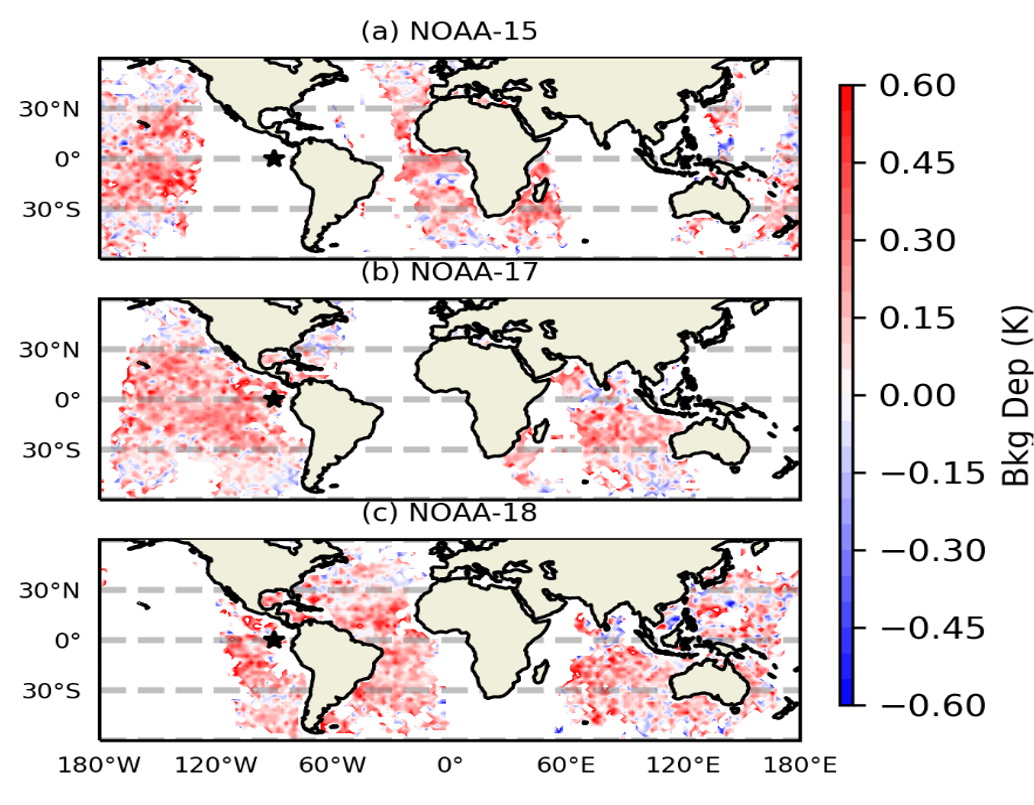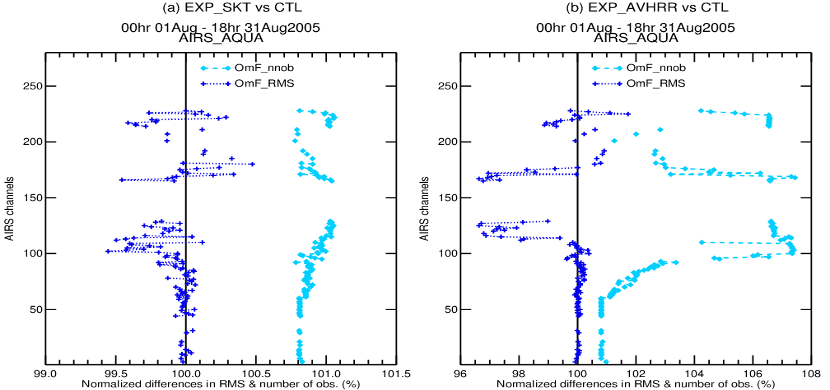Direct Assimilation of AVHRR Satellite Radiance Mmeasurements in a Reanalysis System
Sea surface temperature (SST) is an important variable of any data assimilation and modeling system which aims to accurately represent long time-scale events, such as El-Nino-Southern-Oscillation (ENSO), that evolve over months, to short time-scale events such as convection that can evolve over hours (Diaz et al., 2001 and Sabin et al., 2013). There are, however, many gaps in the available observed in situ data from the ships and buoys which can be filled in with continuous satellite radiance observations. Advanced Very High-Resolution Radiometer (AVHRR) radiance observations span over 30 years and are considered valuable in constraining the SST (Casey et al., 2010). Akella et al. (2017) shows that in GEOS, the near-surface SST variability can be resolved and constrained by including diurnal warming and cool-skin layers and, assimilation of clear-sky AVHRR radiances in addition to SST product from OSTIA (Donlon et al., 2012; Good et al., 2020) which is used as the foundation SST. The capability to assimilate direct radiance from AVHRR in the GEOS forward processing system (GEOS-FP; https://gmao.gsfc.nasa.gov/GMAO_products/NRT_products.php) has improved the forecast skill of the GEOS-FP system, most notably near the surface and satellite radiance assimilation of surface sensitive channels (Akella et al., 2017). This study extends our previous work (Akella et al., 2017, Gentemann and Akella, 2018) which benefits GEOS-FP to the GEOS reanalysis system and specifically highlights the differential impact of AVHRR data in 2005.
New data streams from AVHRR instrument onboard three NOAA satellites (the NOAA-15, NOAA-17 and NOAA-18) are downloaded and preprocessed to be used in GEOS. To assess the impact of assimilation of the additional AVHRR brightness temperature data, three experiments are performed. The first experiment serves as a control experiment (CTL) which does not apply any analysis increment of skin SST to the model, nor does it assimilate AVHRR radiance data. For the second experiment, EXP_SKT, the analysis increment of skin SST is applied via incremental analysis update (IAU). The third experiment, EXP_AVHRR, has the components of EXP_SKT along with the assimilation of new AVHRR data. The monthly mean values of background departure for the three instruments at 18 UTC are shown in Figure 1, which indicates that the mean background of EXP_AVHRR is colder than observations over the tropical ocean between 30o N and 30o S. The positive (warm) bias in the mean background departure does not have a uniform spatial distribution. Also, the bias is larger as the satellite path crosses the region during the local daytime when AVHRR channels 4 and 5 (11 and 12 micron wavelength respectively) are most sensitive to near surface warming due to solar heating. As shown in the following Fig.2, assimilation of this new data improves our assimilation of other satellite data.
Figure 2 (a) shows the percentage difference between the observation count and root mean square error (RMSE) from background departure for EXP_SKT and CTL. Channel indices between 115 and 130 (actual channel numbers between 333 and 950) are surface sensitive channels of Atmospheric Infrared Sounder (AIRS) onboard Aqua satellite with wavenumber between 753 cm-1 and 1001.4 cm-1. The percentage increase in the observation counts between 115 and 130 is noted in EXP_SKT compared to CTL along with a reduction in the percentage of RMSE. The reduction in RMSE suggests a positive synergy from the assimilation of AVHRR data that improves assimilation of other IR radiance such as hyperspectral AIRS. The percentage change in the RMSE and number of assimilated observations between EXP_AVHRR and CTL are shown in Figure 2 (b) where there is a substantial reduction of almost 3% to 4% in the RMSE and an increase in the number of assimilated AIRS observations for the surface sensitive channels. The assimilation of AVHRR radiance has thus reduced the variability in the surface sensitive hyperspectral channels that have already benefited from the skin layer parameterization in the model.


This new AVHRR data stream has been added to the GEOS systems to be used in GEOS reanalysis, such as GEOS for Instrument Teams (GEOS-IT) and various science applications. This snapshot is based on the results presented in Chattopadhyay et al. (2023).
References
Akella, S., Todling, R. and Suarez, M. (2017), Assimilation for skin SST in the NASA GEOS atmospheric data assimilation system. Quart. J. Roy. Meteor. Soc., 143, 1032-1046. Available at https://rmets.onlinelibrary.wiley.com/doi/pdf/10.1002/qj.2988
Casey K.S., Brandon T.B., Cornillon P., and Evans R. (2010), The Past, Present, and Future of the AVHRR Pathfinder SST Program. In: Barale V., Gower J., Alberotanza L. (eds) Oceanography from Space. Springer, Dordrecht. https://doi.org/10.1007/978-90-481-8681-5_16
Chattopadhyay, M., Akella, S., Kim, J., and Bloecker, C. (2023), Direct Assimilation of AVHRR Satellite Radiance measurements in a Reanalysis System. Q J R Meteorol Soc. Accepted Author Manuscript. https://doi.org/10.1002/qj.4583
Diaz, H.F., Hoerling, M.P., and, Eischeid, J.K. (2001), ENSO variability, teleconnections and climate change. International Journal of Climatology, 21: 1845-1862. https://doi.org/10.1002/joc.631
Donlon, C. J., Martin, M., Stark, J., Roberts-Jones J., Fiedler, E., and, Wimmer, W. (2012), The Operational Sea Surface Temperature and Sea Ice Analysis (OSTIA) system. Remote Sens. Environ., 116, 140–158, doi:10.1016/j.rse.2010.10.017.
Gentemann, C. L., and, Akella, S. (2018). Evaluation of NASA GEOS-ADAS modeled diurnal warming through comparisons to SEVIRI and AMSR2 SST observations. Journal of Geophysical Research: Oceans, 123, 1364– 1375. https://doi.org/10.1002/2017JC013186
Good, S., Fiedler, E., Mao, C., Martin, M.J., Maycock, A., Reid, R., Roberts-Jones, J., Searle, T., Waters, J., While, J., Worsfold, M. (2020), The Current Configuration of the OSTIA System for Operational Production of Foundation Sea Surface Temperature and Ice Concentration Analyses. Remote Sens., 12, 720. https://doi.org/10.3390/rs12040720
Sabin, T. P., Babu, C. A. and Joseph, P. V. (2013), SST–convection relation over tropical oceans, Int. J. Climatol., 33: 1424-1435. https://doi.org/10.1002/joc.3522


